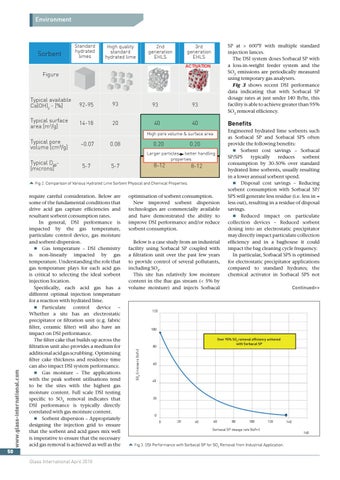Environment
Sorbent
Standard hydrated limes
High quality standard hydrated lime
2nd generation EHLS
SP at > 600°F with multiple standard injection lances. The DSI system doses Sorbacal SP with a loss-in-weight feeder system and the SO2 emissions are periodically measured using temporary gas analysers. Fig 3 shows recent DSI performance data indicating that with Sorbacal SP dosage rates at just under 140 lb/hr, this facility is able to achieve greater than 95% SO2 removal efficiency.
3rd generation EHLS
Figure
Typical available Ca(OH)2 - [%]
92-95
93
Typical surface area [m2/g]
14-18
20
93
93
40
40
Benefits
High pore volume & surface area
Typical pore volume [cm3/g]
~0.07
Typical D50[microns]
5-7
0.08
0.20
0.20
Larger particles better handling properties
8-12
5-7
8-12
require careful consideration. Below are some of the fundamental conditions that drive acid gas capture efficiencies and resultant sorbent consumption rates. In general, DSI performance is impacted by the gas temperature, particulate control device, gas moisture and sorbent dispersion. � Gas temperature – DSI chemistry is non-linearly impacted by gas temperature. Understanding the role that gas temperature plays for each acid gas is critical to selecting the ideal sorbent injection location. Specifically, each acid gas has a different optimal injection temperature for a reaction with hydrated lime. � Particulate control device – Whether a site has an electrostatic precipitator or filtration unit (e.g. fabric filter, ceramic filter) will also have an impact on DSI performance. The filter cake that builds up across the filtration unit also provides a medium for additional acid gas scrubbing. Optimising filter cake thickness and residence time can also impact DSI system performance. � Gas moisture – The applications with the peak sorbent utilisations tend to be the sites with the highest gas moisture content. Full scale DSI testing specific to SO2 removal indicates that DSI performance is typically directly correlated with gas moisture content. � Sorbent dispersion – Appropriately designing the injection grid to ensure that the sorbent and acid gases mix well is imperative to ensure that the necessary acid gas removal is achieved as well as the
optimisation of sorbent consumption. New improved sorbent dispersion technologies are commercially available and have demonstrated the ability to improve DSI performance and/or reduce sorbent consumption. Below is a case study from an industrial facility using Sorbacal SP coupled with a filtration unit over the past few years to provide control of several pollutants, including SO2. This site has relatively low moisture content in the flue gas stream (< 5% by volume moisture) and injects Sorbacal
Continued>>
120
100 Over 95% SO2 removal efficiency achieved with Sorbacal SP
80 SO2 Emissions (lb/hr)
www.glass-international.com
� Fig 2. Comparison of Various Hydrated Lime Sorbent Physical and Chemical Properties.
Engineered hydrated lime sorbents such as Sorbacal SP and Sorbacal SPS often provide the following benefits: � Sorbent cost savings – Sorbacal SP/SPS typically reduces sorbent consumption by 30-50% over standard hydrated lime sorbents, usually resulting in a lower annual sorbent spend. � Disposal cost savings – Reducing sorbent consumption with Sorbacal SP/ SPS will generate less residue (i.e. less in = less out), resulting in a residue of disposal savings. � Reduced impact on particulate collection devices – Reduced sorbent dosing into an electrostatic precipitator may directly impact particulate collection efficiency and in a baghouse it could impact the bag cleaning cycle frequency. In particular, Sorbacal SPS is optimised for electrostatic precipitator applications compared to standard hydrates; the chemical activator in Sorbacal SPS not
60
40
20
0 0
20
40
60
80
100
120
Sorbacal SP dosage rate (lb/hr)
140 160
� Fig 3. DSI Performance with Sorbacal SP for SO2 Removal from Industrial Application.
50 Glass International April 2018
Lhoist.indd 3
16/04/2018 12:39:15
